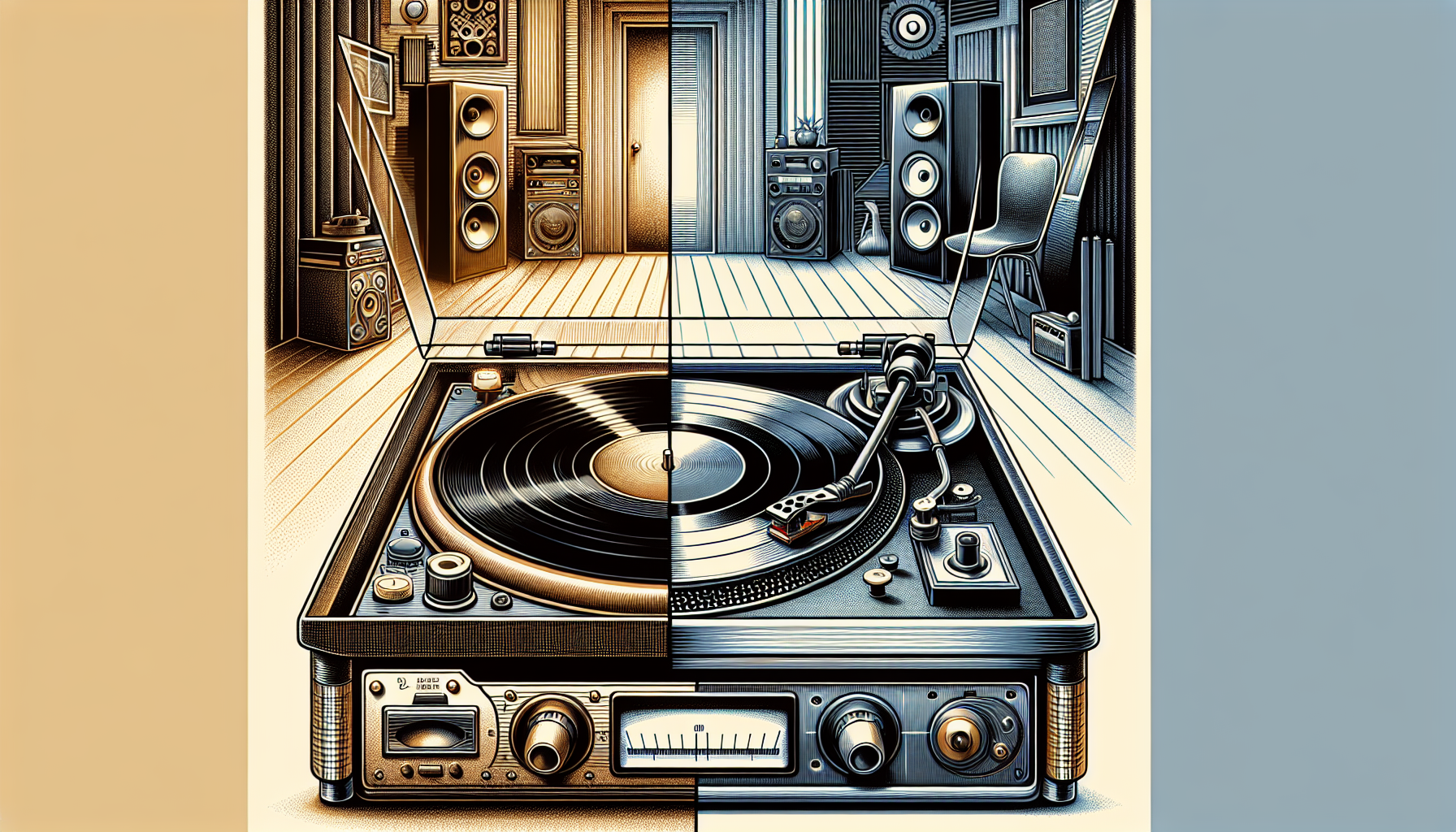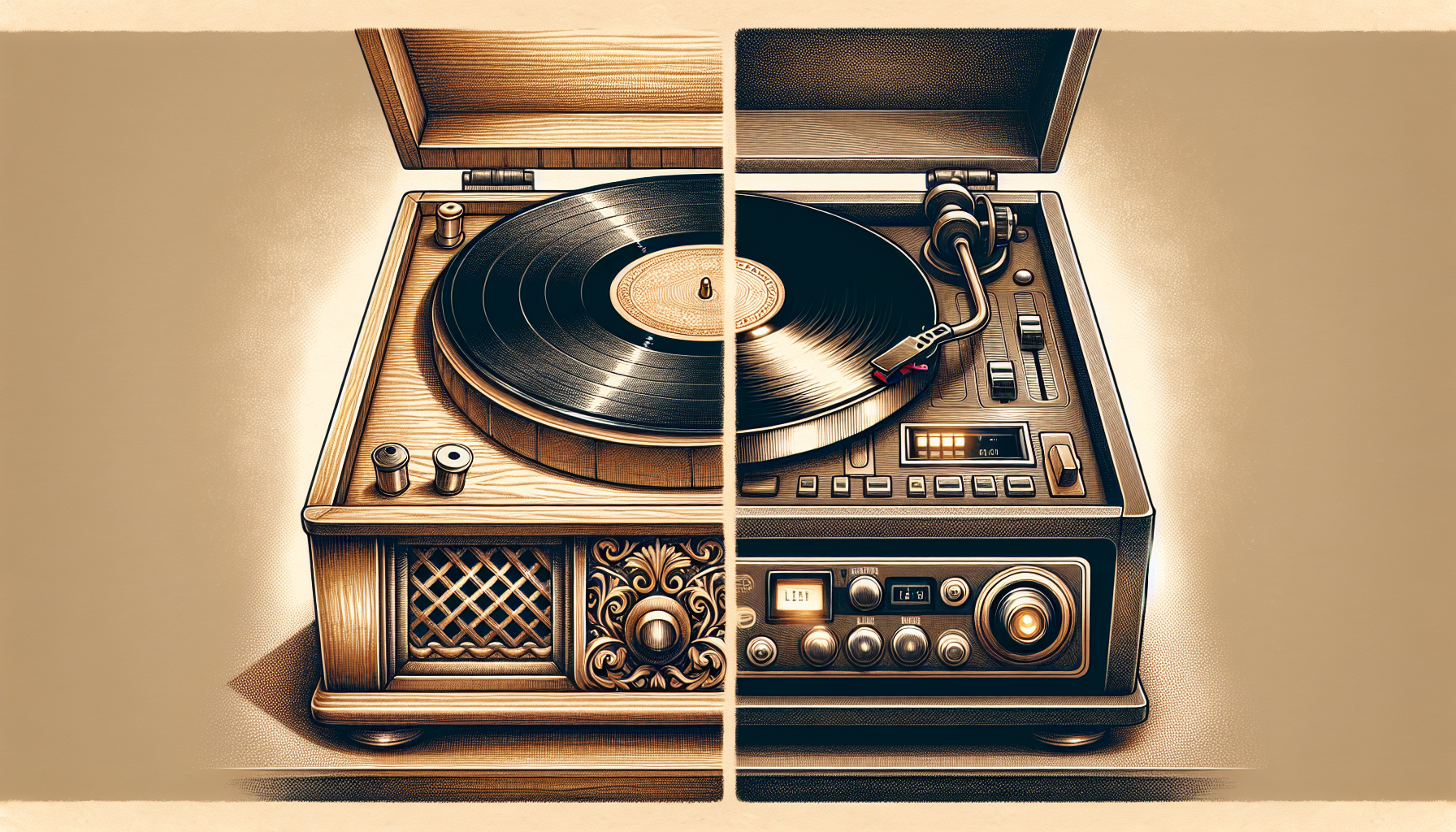Are you a music lover who prefers the rich, authentic sound of vinyl records? If so, you may be wondering about the different types of record players available. In this article, we will explore the two main types of record players, giving you a clear understanding of their features and benefits. Whether you’re a seasoned audiophile or a curious beginner, this informative guide will help you make an informed choice when it comes to enjoying the timeless pleasure of playing vinyl records.
Types of Record Players
When it comes to record players, there are primarily two types: belt drive and direct drive. Each type offers unique features and benefits, and understanding the differences between them can help you make an informed decision when purchasing a record player.
Belt Drive Record Players
Working Mechanism
In a belt drive record player, the motor is located away from the platter. A belt is used to connect the motor to the platter, which rotates the vinyl records. As the motor turns, it drives the belt, which in turn rotates the platter. This mechanism allows for smooth and consistent rotation of the records.
Advantages
One of the major advantages of belt drive record players is their ability to reduce motor noise. Since the motor is isolated from the platter by the belt, there is less direct contact between the two, resulting in quieter operation. This is particularly beneficial for audiophiles who value a clean and pure sound experience.
Another advantage of belt drive record players is their ability to minimize vibration. The belt acts as a dampening mechanism, absorbing any vibrations created by the motor. This reduces the risk of unwanted resonance that can negatively impact the sound quality of your records.
Additionally, belt drive record players are known for their ability to extend the lifespan of your records. The reduced motor noise and lower vibrations ensure that your records are less prone to wear and tear, allowing you to enjoy your vinyl collection for years to come.
Lastly, belt drive record players are often more affordable compared to direct drive models. This makes them a popular choice for beginners or casual listeners who are looking for a quality record player without breaking the bank.
Disadvantages
One potential downside of belt drive record players is their slower start-up time. Since the motor needs to transfer its power through the belt to the platter, it may take a few moments for the platter to reach its optimal speed. However, this is only a minor inconvenience and is generally not a significant issue for most users.
Another drawback of belt drive record players is the variability in speed. Over time, the belt may stretch or wear out, resulting in slight speed fluctuations. While this may not be noticeable to the average listener, it can pose a challenge for DJs or those who require precise and consistent speed control.

Working Mechanism
Belt
The belt in a belt drive record player is typically made of rubber or silicone. This material offers flexibility and durability, allowing it to withstand repeated use without deteriorating. The belt is placed around the motor’s pulley and the platter’s outer rim, providing a reliable connection between the two components.
Motor
In a belt drive record player, the motor is located separately from the platter. This design helps to minimize motor noise and vibration, ensuring a high-quality audio experience. The motor is responsible for driving the belt and turning the platter at the desired speed.
Advantages
Less Motor Noise
Due to the separation of the motor from the platter, belt drive record players significantly reduce motor noise. This creates a quieter listening environment, allowing you to fully immerse yourself in the music without any distracting background sounds.
Lower Vibration
The belt acts as a buffer between the motor and the platter, effectively absorbing vibrations generated by the motor. This results in a smoother playback experience and prevents unwanted resonance that can negatively impact the sound quality.
Longer Lifespan for Records
The reduced motor noise and lower vibrations of belt drive record players contribute to a longer lifespan for your vinyl records. With less wear and tear caused by excessive vibrations, you can enjoy your collection for many years without compromising the sound quality.
Affordability
Belt drive record players are often more affordable compared to direct drive models. This makes them a popular choice for budget-conscious individuals who still desire a high-quality audio experience.
Disadvantages
Slower Start-up Time
One of the drawbacks of belt drive record players is their slower start-up time. Since the motor’s power needs to be transferred through the belt to the platter, it may take a few moments for the platter to reach its optimal speed. However, this is typically a minor inconvenience and does not significantly impact the overall user experience.
Variability in Speed
Over time, the belt in a belt drive record player may stretch or wear out, resulting in slight speed fluctuations. While this may not be noticeable to the average listener, it can pose a challenge for DJs or those who require precise and consistent speed control.

Direct Drive Record Players
Working Mechanism
In contrast to belt drive record players, direct drive record players have the motor located directly underneath the platter. The motor is directly connected to the platter and provides the rotational force required to spin the vinyl records.
Advantages
Direct drive record players offer several advantages that make them a popular choice for professionals and enthusiasts alike. The direct connection between the motor and the platter eliminates the need for a belt, resulting in quicker start-up times. This can be particularly beneficial for DJs who require instant speed control when mixing or scratching.
Additionally, direct drive record players offer more consistent speed control compared to their belt drive counterparts. The direct transmission of power ensures that there are no speed fluctuations caused by stretched or worn-out belts. This makes direct drive record players suitable for precise audio applications that require absolute speed accuracy.
Disadvantages
Despite their many advantages, direct drive record players also have a few drawbacks to consider.
Motor Noise
Since the motor is located directly underneath the platter, direct drive record players are more prone to motor noise compared to belt drive models. This can result in a slight hum or buzz during playback, which may be noticeable in quieter passages of music. However, advancements in motor technology have significantly reduced this issue in modern direct drive record players.
Vibration
Direct drive record players are more prone to vibration compared to belt drive models. The direct connection between the motor and the platter can transmit vibrations, potentially affecting the sound quality. However, many manufacturers employ sophisticated isolation mechanisms to minimize vibrations and ensure optimal audio playback.
Shorter Lifespan for Records
Due to the increased vibration and motor noise, direct drive record players may contribute to a slightly shorter lifespan for your vinyl records. While this may not be a significant concern for most users, those with valuable or delicate records may prefer the dampened vibrations offered by belt drive record players.
Higher Cost
Direct drive record players are generally more expensive compared to belt drive models. The advanced technology and precision engineering required in direct drive mechanisms contribute to higher manufacturing costs. However, for those who require the benefits and performance of direct drive, the higher price may be justified.
In conclusion, both belt drive and direct drive record players offer unique features and benefits. Belt drive record players excel in reducing motor noise, minimizing vibrations, extending the lifespan of records, and affordability. On the other hand, direct drive record players provide quicker start-up times, consistent speed control, and are suitable for professional applications. Consider your specific needs and preferences when choosing between the two types, and enjoy the magical experience of vinyl records with your preferred record player.


